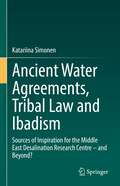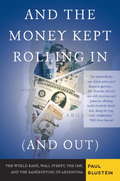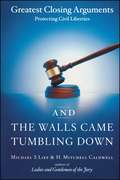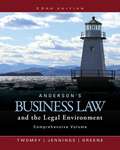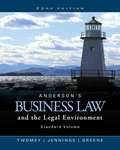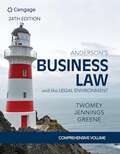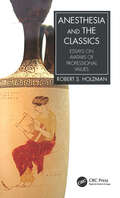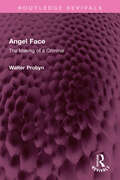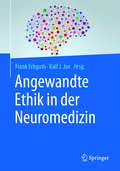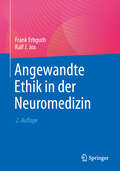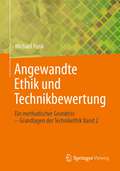- Table View
- List View
Ancient Water Agreements, Tribal Law and Ibadism: Sources of Inspiration for the Middle East Desalination Research Centre – and Beyond?
by Katariina SimonenThis book traces the development of Oman's inclusive agreements and highlights their importance for international negotiations, dealing with issues most relevant to humanity's own survival today, nuclear weapons or climate change.In Oman, a historical seafaring nation on the south-eastern corner of the Arabian Peninsula, a culture of agreement that accommodates the interests of everyone has developed around the division of scarce water resources.Life in the arid inland of the Omani Hajar mountains would not have been possible without water. Irrigation channel (falaj) construction is extremely old and skilful therein. Local practices evolved around the division of water and land on the basis of fairness. The community would be best served by inclusion and the avoidance of conflict.A specific Islamic school called Ibadi arrived at Oman early on in the eighth century. Ibadi scholars conserved local practices. Consultation and mediation by sheikhs and the religious leader, Imam, became the law of the land. The Omanis were known as the People of Consultation, Ahl Al Shura. In time, the practice of inclusive agreements would extend far beyond the village level, affecting Oman´s foreign policy under Sultan Qaboos. Oman´s water diplomacy succeeded in uniting the contestants of the Middle East Peace Process in the 1990s to work together on common problems of water desalination.
And Give Up Showbiz?: How Fred Levin Beat Big Tobacco, Avoided Two Murder Prosecutions, Became a Chief of Ghana, Earned Boxing Manager of the Year, and Transformed American Law
by Josh YoungIn the early '90s, Big Tobacco was making a killing. There was no entity more powerful, and national tobacco-related deaths numbered in the hundreds of thousands each year. The economic loss from smoking-related illnesses was billions of dollars. And yet, Big Tobacco had never paid a nickel in court. Until one Southern, small-town lawyer figured out how Florida could sue Big Tobacco to reimburse the state for health care costs. The end result? Beyond the $13 billion settlement, hundreds of thousands of American lives have been, and will continue to be, saved. Meet Fred Levin. Called by his own son &“a philanthropist and a cockroach," Fred Levin is no ordinary attorney, and his remarkable story is far from squeaky clean. In And Give Up Showbiz?, New York Times bestselling author Josh Young works closely with Levin to give readers a glimpse into the extraordinary and entertaining life of the top trial lawyer who was a pioneer in establishing American personal injury law. Seen as an inspiring innovator by some and a flamboyant self-promoter by others, Levin has not only fought against Big Tobacco, he has won victories for women, African Americans, and workers everywhere. Levin's unprecedented legal career is just one aspect of his roller-coaster life story. From managing one of the world's greatest boxers to avoiding multiple disbarment attempts, and from becoming a chief in the country of Ghana to even being a person of interest in two separate murder investigations, his story reads like a novel suitable for the silver screen. And Give Up Showbiz? is both shockingly candid and wildly funny.
And Justice For All (Literature & Thought Series)
by Perfection Learning StaffContains short stories, poems, biographical accounts, and essays about justice -- what it is, who determines it, how to achieve it for all and how to protect the right to it.
And Justice for All
by Perfection Learning StaffContains short stories, poems, biographical accounts, and essays about justice -- what it is, who determines it, how to achieve it for all and how to protect the right to it.
And Never See Her Again
by Patricia SpringerThe true story of the abduction and murder of Opal Jo Jennings in 1999.
And Sometimes They Kill You: Confronting the Epidemic of Intimate Partner Violence
by Pamela CrossDespite decades of activism by feminists and their allies, women and their children continue to be killed by their partners and former partners in shocking numbers, leading the federal government to describe intimate partner violence (IPV) as an epidemic in Canada. Why have we failed to respond effectively to a social problem that affects millions of women and children? After working for more than three decades with survivors, frontline workers, and the systems they turn to for help, lawyer Pamela Cross provides an in-depth look at intimate partner violence in Canada. And Sometimes They Kill You untangles what intimate partner violence is, the barriers to its eradication, and what we could be doing to eliminate those barriers. Told in an engaging and accessible fashion, the book weaves together Cross’ personal experiences and reflections on what she has learned with the heartbreaking stories of victims, survivors, and the alarming but convincing data. Cross offers practical and hopeful ideas for how each of us can engage in the vital work of eradicating intimate partner violence. This a call-to-action for the all-of-society, revolutionary response to gender-based violence needed to build communities that are safe and healthy for everyone.
And Still the Waters Run: The Betrayal of the Five Civilized Tribes
by Angie DeboEVERY schoolboy knows that from the settlement of Jamestown to the 1870's Indian warfare was a perpetual accompaniment of American pioneering
And the Money Kept Rolling In (and Out) Wall Street, the IMF, and the Bankrupting of Argentina
by Paul BlusteinIn the 1990s, few countries were more lionized than Argentina for its efforts to join the club of wealthy nations. Argentina's policies drew enthusiastic applause from the IMF, the World Bank and Wall Street. But the club has a disturbing propensity to turn its back on arrivistes and cast them out. That was what happened in 2001, when Argentina suffered one of the most spectacular crashes in modern history. With it came appalling social and political chaos, a collapse of the peso, and a wrenching downturn that threw millions into poverty and left nearly one-quarter of the workforce unemployed. Paul Blustein, whose book about the IMF, The Chastening, was called "gripping, often frightening" by The Economist and lauded by the Wall Street Journal as "a superbly reported and skillfully woven story," now gets right inside Argentina's rise and fall in a dramatic account based on hundreds of interviews with top policymakers and financial market players as well as reams of internal documents. He shows how the IMF turned a blind eye to the vulnerabilities of its star pupil, and exposes the conduct of global financial market players in Argentina as redolent of the scandals #151; like those at Enron, WorldCom and Global Crossing #151; that rocked Wall Street in recent years. By going behind the scenes of Argentina's debacle, Blustein shows with unmistakable clarity how sadly elusive the path of hope and progress remains to the great bulk of humanity still mired in poverty and underdevelopment.
And the Poor Get Prison: Economic Bias in American Criminal Justice
by Jeffrey ReimanFrom the preface: It is obvious that the American criminal justice system is failing in the war against crime and equally obvious that American criminal justice policies often contribute to the very problem that they seek to solve. This book is an attempt to understand this failure: its dimensions, its mechanisms, its causes, and its possible solutions. To understand the failure of the American criminal justice system to protect us, it is necessary to see that the failure is not haphazard. It has a pattern. The criminal justice system devotes most of its resources to fighting against crimes like murder and mugging, crimes characteristically committed by the poor in our society. And, although our prisons are filled with poor criminals, little dent is made in the overall volume of their crimes. Indeed, there is reason to believe that prisons serve more as training grounds for future criminality than for good citizenship.
And the Sea Will Tell
by Vincent T. Bugliosi Bruce B. HendersonOnly the most adventuresome, or desperate, would plan an extended stay here. This is the true story of two men and two women who did. One married couple,two lovers. Four lives forever changed on an island that never wanted company. Each of the visitors sought escape from the world, but for very different reasons, their destinies intersecting on this deserted atoll. Not all of them would leave alive. The mystery shrouding their fate would be as dark and chilling as the ocean floor deep beneath Palmyra Island.
And the Walls Came Tumbling Down: Greatest Closing Arguments Protecting Civil Liberties
by H. Mitchell Caldwell Michael S. LiefThe second volume in a must-have trilogy of the best closing arguments in American legal history Every day, Americans enjoy the freedom to decide what we do with our property, our bodies, our speech, and our votes. However, the rights to these freedoms have not always been guaranteed. Our civil rights have been assured by cases that have produced monumental shifts in America's cultural, political, and legal landscapes. And the Walls Came Tumbling Down showcases eight of the most exciting closing arguments in civil law -- from the Amistad case, in which John Quincy Adams brought the injustice of slavery to the center stage of American politics, to the Susan B. Anthony decision, which paved the way to success for women's suffrage, to the Larry Flynt trial, in which the porn king became an unlikely champion for freedom of speech. By providing historical and biographical details, as well as the closing arguments themselves, Lief and Caldwell give readers the background necessary to fully understand these important cases, bringing them vividly to life.
Anderson's Business Law And The Legal Environment: Comprehensive Volume
by Stephanie Greene David Twomey Marianne JenningsTrust today’s #1 business law book with summarized cases to present exceptionally clear discussions of the law at just the right level of detail. The 23rd Edition of ANDERSON'S BUSINESS LAW & THE LEGAL ENVIRONMENT - COMPREHENSIVE EDITION is updated throughout for proven comprehensive coverage that does not overwhelm readers with unnecessary detail. You’ll find an incredible wealth of integrated examples and applications that feature current events and familiar situations to clarify key legal concepts. Special “For Example” brief examples and applications further emphasize the relevance of what you are learning as you progress through each chapter’s narrative. In addition, clear and thorough insights help you prepare for success on today’s CPA exam.
Anderson's Business Law and the Legal Environment, Standard Volume (23rd Edition)
by Stephanie Greene Marianne M. Jennings David P. TwomeyPrepare to ace your business law course as this brief version of the #1 summarized case business law text on the market today helps you grasp key legal concepts and principles. ANDERSON'S BUSINESS LAW & THE LEGAL ENVIRONMENT, STANDARD VOLUME, 23E reinforces your understanding through applications and examples of real-world dilemmas, issues, and problems. You'll also find invaluable information and resources to assist you in studying for the CPA exam. Current, easy-to-understand and fascinating to read, ANDERSON'S BUSINESS LAW & THE LEGAL ENVIRONMENT, STANDARD VOLUME helps you prepare for class with all of the in-text and online resources you need to succeed in your business law course.
Anderson’s Business Law and the Legal Environment: Comprehensive Volume
by David P. Twomey Marianne Moody Jennings Stephanie M. GreeneGain a strong understanding of business law as it's practiced today with the comprehensive, yet clear, approach found in today's number one business law resource with summarized cases: ANDERSON'S BUSINESS LAW & THE LEGAL ENVIRONMENT, COMPREHENSIVE VOLUME, 24E. <p><p>This reader-friendly approach helps you grasp legal concepts and principles without overwhelming detail. You examine the latest developments in law with new cases as recent as 2020 and examples from current headlines. Clearly identified content helps you prepare for the current CPA exam. <p><p>In addition, summarized cases, numerous examples of today's real legal dilemmas, meaningful applications and interesting learning features emphasize the relevance of what you are learning. You examine legal concepts at work in examples such as rapper 50 Cent's bankruptcy, Netflix's battle with Hollywood and popular online retailer Wayfair's legal battles. MindTap digital resources are also available to help you succeed in your business law course.
Android Malware and Analysis
by Ken Dunham Shane Hartman Manu Quintans Jose Andre Morales Tim StrazzereThe rapid growth and development of Android-based devices has resulted in a wealth of sensitive information on mobile devices that offer minimal malware protection. This has created an immediate need for security professionals that understand how to best approach the subject of Android malware threats and analysis.In Android Malware and Analysis, K
Anesthesia and the Classics: Essays on avatars of professional values
by Robert S. HolzmanA collection of 25 thought provoking Essays which create a bridge between the Classical personification of values and link them to current training and education in Western Medicine. This readable and erudite text provides a framework for modern clinical values - with a particular emphasis on anesthesiology - set in the context of ageless dilemmas facing each generation of physicians. Medicine as a profession carries some specific obligations.The qualities of empathy, knowledge, generosity, respect, and scholarship provide a "family" of values that was personified by the Ancients in the family of Asklepios, and which form the basis of professional values today. Moreover, a substantial amount of professional growth should come from reflection based on the experience of caring for real patients – an appreciation of the human condition. Each essay within this beautifully crafted book illustrates the importance of expertise, skill, focus, mindfulness, and collaboration, all of which are integral to professionalism in medicine, and in particular to those working in the field of anesthesiology. Anesthesiologists, Certified Registered Nurse Anesthetists and Anesthesia Assistants will find much to enhance their professional understanding within this text. The principles, values and traits of professionalism are relevant to all medical specialties and these essays provide a lyrical understanding of the traits required for professional development.
Angel Face: The Making of a Criminal (Routledge Revivals)
by Walter ProbynFirst published in 1977, Angel Face documents the penal life of Walter Probyn, who spent 30 out of 44 years in prison and escaped 15 times. He describes the succession of events which began when he was a nine-year-old ‘blitz kid’ who ‘stole’ a can of peas from a bombed shop, and tells in absorbing and harrowing detail his time in prison and on the run. Important though his description and indictment of prison life and the treatment of so-called hardened offenders may be, his particular attention to carefully planned and ingenious escapes gives great insight into his fight for retaining his independence and his insatiable craving for freedom. This is not a book which glamourises crime. It does raise serious and debatable questions about the need for reform of a penal system which has failed in its objectives. These questions are discussed in an introduction and final commentary by noted criminologist, Stan Cohen, who puts Probyn’s story into a wider context. His life is a classic example of the way in which the penal system, far from curing crime, may actually encourage it, by strengthening the resolve and bitterness of those who resist being institutionalised and fitting into authority’s moulds. But is three-quarters of a lifetime a responsible price to pay? The authorities and Walter Probyn give different answers. This book will be of interest to anyone intrigued by the other side of the penal system but especially to students of law, criminology, and sociology.
Angel of Mercy (Shannon Saga #3)
by Tracie Peterson James S. BellWith her faith tested and her heart torn, how will Kit find her way?
Angels Flight (Harry Bosch Series #6)
by Michael ConnellyA lawyer is found murdered on the eve of a landmark trial at the foot of Angels Flight in the heart of downtown Los Angeles. The superb sixth Harry Bosch novel from the award-winning No. 1 bestselling author. BOSCH TV STARTS FEBRUARY 2015.Harry Bosch finds himself yet again in charge of a case that no one else will touch. This time his job is to nail the killer of hot shot black lawyer Howard Elias. Elias has been found murdered on the eve of going to court on behalf of Michael Harris, a man the LAPD believes guilty of the rape and murder of a twelve-year-old girl. Elias had let it be known that the aim of his civil case was not only to reveal the real killer but to target and bring down the racist cops who beat up his client during a violent interrogation. Now it's all down to Bosch - and he's got to take a long, hard look at some of his colleagues in a police department that is rife with suspicion and hatred.
Angels Flight (Harry Bosch Series #6)
by Michael ConnellyHarry Bosch finds himself yet again in charge of a case that no one else will touch. This time his job is to nail the killer of hot shot black lawyer Howard Elias. Elias has been found murdered on the eve of going to court on behalf of Michael Harris, a man the LAPD believes guilty of the rape and murder of a twelve-year-old girl. Elias had let it be known that the aim of his civil case was not only to reveal the real killer but to target and bring down the racist cops who beat up his client during a violent interrogation. Now it's all down to Bosch - and he's got to take a long, hard look at some of his colleagues in a police department that is rife with suspicion and hatred.Read by Peter Giles(p) 2013 Hachette Audio
Angels Flight (Shannon Saga #2)
by Tracie Peterson James S. BellHaving taken Los Angeles by storm, Kit finds herself in a political storm when her next case crosses racial lines. Shannon Saga Book 2.
Anger: The Conflicted History of an Emotion (Vices and Virtues)
by Barbara H. RosenweinTracing the story of anger from the Buddha to Twitter, Rosenwein provides a much-needed account of our changing and contradictory understandings of this emotion All of us think we know when we are angry, and we are sure we can recognize anger in others as well. But this is only superficially true. We see anger through lenses colored by what we know, experience, and learn. Barbara H. Rosenwein traces our many conflicting ideas about and expressions of anger, taking the story from the Buddha to our own time, from anger&’s complete rejection to its warm reception. Rosenwein explores how anger has been characterized by gender and race, why it has been tied to violence and how that is often a false connection, how it has figured among the seven deadly sins and yet is considered a virtue, and how its interpretation, once largely the preserve of philosophers and theologians, has been gradually handed over to scientists—with very mixed results. Rosenwein shows that the history of anger can help us grapple with it today.
Angewandte Ethik in der Neuromedizin
by Ralf J. Jox Frank ErbguthDas Praxisbuch zeigt anhand verschiedener klinischer Situationen in der Neuromedizin, wie die wissenschaftliche Reflexion auf dem Gebiet der Neuroethik praktisch angewendet werden kann. Es richtet sich prim#65533;r an #65533;rzte sowie alle anderen Gesundheitsberufe, die in Neurologie, Neurochirurgie oder Neuroradiologie mit ethischen Fragen konfrontiert sind, die sich speziell in ihrem T#65533;tigkeitsbereich ergeben. Indem es den klinischen Kontext in den Blick r#65533;ckt, schlie#65533;t das Werk die L#65533;cke zwischen Einf#65533;hrungsb#65533;chern und wissenschaftlichen Handb#65533;chern zur Neuroethik. Der Themenkanon umspannt die wesentlichen relevanten Felder der Neuroethik von der klinischen Ethikberatung bis zu einzelnen ethischen Fragen in der Neurodiagnostik, bei Neurointerventionen und in speziellen neuroklinischen Situationen. Herausgegeben von einem wissenschaftlich t#65533;tiger Ethiker und Neurologen und einem Krankenhausneurologen, wirken an dem Buch Experten aus verschiedenen Disziplinen und L#65533;ndern mit.
Angewandte Ethik in der Neuromedizin
by Ralf J. Jox Frank ErbguthAnhand ausgewählter klinischer Situationen in der Neuromedizin zeigt dieses Buch, wie die wissenschaftliche Reflexion auf dem Gebiet der Neuroethik praktisch angewendet werden kann. Es richtet sich primär an Ärztinnen und Ärzte sowie an alle anderen Gesundheitsberufe, die in den Bereichen der Neuromedizin mit ethischen Fragen konfrontiert sind, die sich speziell in ihrem Tätigkeitsbereich ergeben. Indem es den klinischen Kontext in den Blick rückt, schließt das Werk die Lücke zwischen Einführungsbüchern und wissenschaftlichen Handbüchern zur Neuroethik. Das breite Themenspektrum wurde für die vollständig aktualisierte 2. Auflage um ein Kapitel zum gegenwärtigen Einsatz von Künstlicher Intelligenz in der Neuromedizin erweitert. Herausgegeben von einem Krankenhausneurologen und einem wissenschaftlich tätigen Neuroethiker, enthält das Buch Beiträge von Expertinnen und Experten aus verschiedenen Disziplinen und Ländern.
Angewandte Ethik und Technikbewertung: Ein methodischer Grundriss – Grundlagen der Technikethik Band 2
by Michael FunkWie bilde ich mir ein ethisches Urteil, um Konflikten zu begegnen? Was ist Technik und wer ist verantwortlich, wenn sie versagt? Stehen Menschen noch im Mittelpunkt – obwohl oder gerade weil Maschinen immer „smarter“ werden? Fragen wie diese verlangen nach einer übersichtlichen und verständlichen Präsentation ethischer Methoden der Technikbewertung. Dabei rückt vorliegendes Buch die Auseinandersetzung mit den Folgen, Risiken und Nebeneffekten technischen Handelns in den Mittelpunkt. Diese reichen von ökologischen Fragen der Entsorgung über Zweckentfremdung bis hin zur individuellen und kollektiven Verantwortung von Ingenieur*innen. Aufbauend auf Grundlagen der angewandten Ethik wird in Bottom-up- und Top-down-Verfahren die Kasuistik sowie analogisch-vergleichende und logisch-ableitende Urteilsbildung eingeführt. Wesentliche Charakteristika technischen Handelns sowie Akteursrollen werden systematisch vorgestellt. Abbildungen, Beispiele und Aufgaben runden den verständlichen Aufbau ab. Als methodischer Grundriss richtet sich vorliegendes Buch an Ingenieurwissenschaftler*innen, Informatiker*innen und Geisteswissenschaftler*innen im Berufsalltag, aber auch an interessierte Lai*innen, die mehr über ethische Praxis erfahren wollen. Es bildet den zweiten, in sich abgerundeten Teil der Buchreihe Grundlagen der Technikethik.Haben wir die Technik, die wir brauchen, und brauchen wir die Technik, die wir haben?
